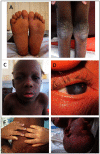Hearing Impairment Overview in Africa: the Case of Cameroon
- PMID: 32098311
- PMCID: PMC7073999
- DOI: 10.3390/genes11020233
Hearing Impairment Overview in Africa: the Case of Cameroon
Abstract
The incidence of hearing impairment (HI) is higher in low- and middle-income countries when compared to high-income countries. There is therefore a necessity to estimate the burden of this condition in developing world. The aim of our study was to use a systematic approach to provide summarized data on the prevalence, etiologies, clinical patterns and genetics of HI in Cameroon. We searched PubMed, Scopus, African Journals Online, AFROLIB and African Index Medicus to identify relevant studies on HI in Cameroon, published from inception to 31 October, 2019, with no language restrictions. Reference lists of included studies were also scrutinized, and data were summarized narratively. This study is registered with PROSPERO, number CRD42019142788. We screened 333 records, of which 17 studies were finally included in the review. The prevalence of HI in Cameroon ranges from 0.9% to 3.6% in population-based studies and increases with age. Environmental factors contribute to 52.6% to 62.2% of HI cases, with meningitis, impacted wax and age-related disorder being the most common ones. Hereditary HI comprises 0.8% to 14.8% of all cases. In 32.6% to 37% of HI cases, the origin remains unknown. Non-syndromic hearing impairment (NSHI) is the most frequent clinical entity and accounts for 86.1% to 92.5% of cases of HI of genetic origin. Waardenburg and Usher syndromes account for 50% to 57.14% and 8.9% to 42.9% of genetic syndromic cases, respectively. No pathogenic mutation was described in GJB6 gene, and the prevalence of pathogenic mutations in GJB2 gene ranged from 0% to 0.5%. The prevalence of pathogenic mutations in other known NSHI genes was <10% in Cameroonian probands. Environmental factors are the leading etiology of HI in Cameroon, and mutations in most important HI genes are infrequent in Cameroon. Whole genome sequencing therefore appears as the most effective way to identify variants associated with HI in Cameroon and sub-Saharan Africa in general.
Keywords: Africa; Cameroon; etiologies; genetics; hearing impairment; prevalence.
Conflict of interest statement
The authors declare no conflict of interest.
Figures



References
-
- WHO Estimates. [(accessed on 29 December 2019)]; Available online: http://www.who.int/deafness/estimates/en/
-
- James M., Kumar P., Ninan P.J. A study on prevalence and risk factors of hearing impairment among newborns. Int. J. Contemporary Pediatr. 2018;5:304–309. doi: 10.18203/2349-3291.ijcp20180018. - DOI
Publication types
MeSH terms
Substances
Grants and funding
LinkOut - more resources
Full Text Sources

